
A book that further explains the Irminsul. This is not offered with the tapestry, but you can read about it by entering "Irminsul" with the author's name to your favorite search engine.
|

This is the re-created tapestry that we offer; it will have fringed edges. Here is a marvelous opportunity to own such an important and esquisite artifact.
|

 ceremonies at the Extersteine. Note the bent-over Irminsul. ceremonies at the Extersteine. Note the bent-over Irminsul.
|

Entrance hall of the  -Ahnenerbe offices in Berlin. -Ahnenerbe offices in Berlin.
Here you can see the original Irminsul tapestry as it hung there.
|

Irminsul bread plate
|

| 
This symbol appears on all  -Ahnenerbe stationary. -Ahnenerbe stationary.
|

 -Standartenführer Wolfram Sievers -Standartenführer Wolfram Sievers
General Secretary of the  -Ahnenerbe -Ahnenerbe
|

Wolfram Sievers
Director of the  -Ahnenerbe -Ahnenerbe
|

Dr. Walter Darré, Racial Theoretician
The first patron of the  -Ahnenerbe -Ahnenerbe
|
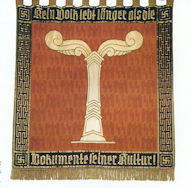
The original Ahnenerbe tapestry as found
|
|
Superb Re-creation of the Famed Ahnenerbe Tapestry with Irminsul (Item ART 18-2; RECTAPESTRY 1-9; AHN 5-3)
|
DESCRIPTION: Here we proudly present a fantastic replica of the tapestry that hung in the foyer of the Ahnenerbe-Stiftung Verlag in Berlin. This was the ancestral heritage institution that was the pet project of SS-Reichsführer Heinrich Himmler. Established by Himmler in 1935, this was an academy and society concerned with prehistory. See on our site the SS-Ahnenerbe ring and the Third Reich Ahnenerbe section AHN1-1. This was certainly the most-learned group within the National Socialist structure. Its members studied all the beginnings and ancient culture of the Teutonic people and kindred races. Among expeditions of Ahnenerbe personnel that were conducted were trips to Tibet and other far-off lands. The original tapestry was found to have been designed by professor and Oberführer-SS Karl Diebitsch and constructed by his sister Else Seifert. Much about Herr Diebitsch can be seen by going to Wikipedia and you can also go to our site and see original tapestries by Diebitsch and others by going to the Third Reich section and then to the subject SS and N.S. tapestries. Having owned the original of this tapestry we at Germania became rather enamored with it and the importance of it so we decided to commission a replica of it and that is what we presently offer. The piece came out in superlative form; the only difference, of course, is size and the copy has fringes all around the edges as it is truly an afghan in nature.
The Tapestry and the Irminsul
The words that are seen top and bottom of the tapestry are “Kein Volk lebt länger als die Dokumente seiner Kultur”–“No people live longer than the documentation of their culture.” This statement was pronounced by Adolf Hitler on the occasion of the opening of the Munich art museum Haus der Deutschen Kunst on 18 July 1937. Karl Diebitsch knew that no more fitting words could ever be more appropriate for this Ahnenerbe tapestry and for its central motif he chose the Irminsul. This was a sacred pillar-like object that played an important role in the Germanic paganism of the Saxon people. It represented the Saxon Tree of Life that held up the circumpolar stars and the immortals of the heavens—the stars that kept time for the ancients and is represented in all Caucasian tribes from the Teutons, Celts, Romans, Greeks and Egyptians. The swastika, was one of our oldest Aryan symbols. This sacred Irminsul was said to have been at the top of the Extersteine near Detmold, Germany. This is a very famous rock formation that magnificently and mysteriously juts up from the ground, and was a place of worship for the ancient Teutons. Ahnenerbe archaeologist Wilhelm Teudt in 1929, interpreted much in his studies about the connection between the Irminsul and the Extersteine. In 1934 and 1935, the SS Ahnenerbe undertook extensive fieldwork in an attempt to uncover material evidence of the use of the Extersteine as a place of pagan worship. The rocks came to have great spiritual meaning to the SS in general and many SS sponsored trips by German citizens were offered, and certain reenactments and SS ceremonies were held there. On the area considered the front of the rock formations can be seen a Christian relief carved into the rocks and dated to the early ninth century. It is a crucifixion scene. If one looks closely at Nicodemus as he helps to lift the crucified Jesus from the cross he seems to have stood on the bent Irminsul as a symbol of triumphant victory for Christianity. The artist K. Diebitsch and Wolfram Sievers, who was the managing director of the Ahnenerbe and rose to rank of SS-Standartenführer, decided to reerect the Irminsul in keeping with their immense interest in bringing the past to the present and the future. The Irminsul became the official seal of the Deutsches Ahnenerbe. The tapestry we offer is huge and measures 74 x 54 inches. It’s 100-percent American made cotton and prewashed for softness and washable in cold water. It has four different types of special stitching and threads (This is not a print on fabric!). All is woven and absolutely awe inspiring when properly displayed. By using this type of weaving there is almost a 3D effect. The colors, the quality of artwork is in a word–SUPERB! The original was sold over 20 years ago for more than $22,000. You can consider this offer to be Germania’s service to history.
PRICE: SOLD
|

|

Prince Josias in SS uniform
|
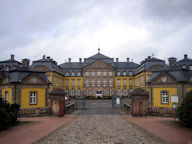
Arolsen Castle in Bad Arolsen, Hesse, Germany
|
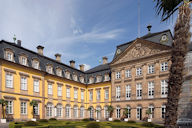
View of the Inner court of the castle
|

Star of the Arolsen crest as used today
|

Waldeck und Pyrmont Coat of Arms.
Note the Arolsen star in the center
|

Professor Karl Diebitsch at the SS Allach showrooms
|

The prince as  -Obergruppenführer (general) -Obergruppenführer (general)
|
|
Super Re-creation of the  Tapestry of SS-Obergruppenführer and Hereditary Prince Josias von Waldeck und Pyrmont (Item ART 18-3; AHN 5-4; RECTAPESTRY 1-10) Tapestry of SS-Obergruppenführer and Hereditary Prince Josias von Waldeck und Pyrmont (Item ART 18-3; AHN 5-4; RECTAPESTRY 1-10)
|
DESCRIPTION: Here is a re-creation of the tapestry that hung in the office of a royal prince of a royal German house. Prince Josias was one of the earliest members of the SS, and one of the first of the royal lines to join the ranks of the Schutzstaffel. The Erbprinz (“hereditary prince”) had an extraordinary and varied career and enjoyed an especially close relationship with Heinrich Himmler. He was born in Arolsen at the ruling family's castle, as the eldest son and heir of Prince Friedrich of Waldeck and Pyrmont, and his consort Princess Bathildis of Schaumburg-Lippe. He was the nephew of William II, King of Württemberg, and Emma of Waldeck and Pyrmont, Queen Regent of the Netherlands. He was badly wounded in WWI (including being a victim of a gas attack) and highly decorated receiving the Iron Cross First and Second Class and other decorations. He later volunteered for the Free Corps, (Freikorps) where he fought in Upper Silesia against the communists in 1919. Josias joined the Nazi Party in 1929, and the SS in 1930. He had married one of the sisters of the Hereditary Grand Duke Nikolaus of Oldenburg (1897-1970). Von Oldenburg’s two sisters married an SS major who was a prince of Schaumburg-Lippe; and SA Colonel Harald von Hedemann, making this a tight-knit circle of aristocratic NSDAP officials. During his first year in the SS, Josias became the chief of Himmler’s personal staff. Later, in 1933, he became the aide-de-camp of SS General Sepp Dietrich, who headed up Hitler’s personal security. That same year, he was promoted to major general (SS-Grüppenführer); this was part of his precipitous rise in rank. He also had a brief appointment as a counselor in the foreign office in 1933, and held a seat in the Reichstag throughout the era of the Third Reich. As of 1936, he headed the SS division of Fulda putting him in close proximity to Prince Philipp of Hessen, who was also an NSDAP royal and a high-ranking SA leader. Both Prince Josias and Prince Philipp were based in the city of Kassel. In Kassel, Josias created the Bureau for the Germanization of Eastern Peoples, which promoted the idea of SS-directed settlements in Eastern Europe. In 1939, he was appointed the higher SS and police leader in Weimar and in this capacity he had supervisory authority over the concentration camp at Buchenwald. The prince was also a general of the Ordnungspolizei (“regular police”) being personally appointed by Hitler in April 1941. Prince Josias was severe, hard driving, and ambitious. To cite an example, he oversaw an SS execution commando action at the Stadelheim Prison near Munich during the Röhm purge in June 1934, when he had to order the executions of several former comrades. It gave him no pleasure, but it was necessary to the future of the NSDAP, which he would defend with his own life, if necessary: “Wenn alle untreu werden, so bleiben wir doch true”: the  motto meaning: “If all become unfaithful, we remain loyal.” The city of Kassel was the main headquarters of the prince, but the SS-Oberabschnitt Fulda-Werra, headed by Josias, was in the town of Arolsen. The stately Arolsen Castle, which continues to serve as the family home of the former ruling family of the Principality of Waldeck and Pyrmont, is also located in Bad Arolsen. The innermost offices of Prince Josias were in the castle itself and the original of this tapestry that we offer graced the wall of his personal office in that regal castle. The symbol of the eight-pointed star—seen in different forms—is seen in the coat of arms of Arolsen; sometimes, the Waldeck arms are shown with a six-pointed star, but the prince chose to have the eight-pointed version on his personal tapestry. Note: the tapestry, like the famed Ahnenerbe example, has in its borders a series of geometric patterns that resemble a continuous pattern comprised of the letter “H” joined. Was this in honor of Heinrich Himmler? The background of the tapestry is decorated with alternating swastikas and motto meaning: “If all become unfaithful, we remain loyal.” The city of Kassel was the main headquarters of the prince, but the SS-Oberabschnitt Fulda-Werra, headed by Josias, was in the town of Arolsen. The stately Arolsen Castle, which continues to serve as the family home of the former ruling family of the Principality of Waldeck and Pyrmont, is also located in Bad Arolsen. The innermost offices of Prince Josias were in the castle itself and the original of this tapestry that we offer graced the wall of his personal office in that regal castle. The symbol of the eight-pointed star—seen in different forms—is seen in the coat of arms of Arolsen; sometimes, the Waldeck arms are shown with a six-pointed star, but the prince chose to have the eight-pointed version on his personal tapestry. Note: the tapestry, like the famed Ahnenerbe example, has in its borders a series of geometric patterns that resemble a continuous pattern comprised of the letter “H” joined. Was this in honor of Heinrich Himmler? The background of the tapestry is decorated with alternating swastikas and  runes, while the Irminsul Ahnenerbe tapestry has in it a background with alternating N.S. eagles and runes, while the Irminsul Ahnenerbe tapestry has in it a background with alternating N.S. eagles and  runics. We believe this is rather evidentiary that both of these tapestries were designed by the famed SS-Oberführer and Professor Karl Diebitsch, the originator of the SS Allach porcelain firm. More information about professor Diebitsch and the Ahnenerbe can be found at on this site here. So, dear collector, here is a chance to procure a great and accurate replica of a very important relic of the Reich. runics. We believe this is rather evidentiary that both of these tapestries were designed by the famed SS-Oberführer and Professor Karl Diebitsch, the originator of the SS Allach porcelain firm. More information about professor Diebitsch and the Ahnenerbe can be found at on this site here. So, dear collector, here is a chance to procure a great and accurate replica of a very important relic of the Reich.
PRICE: SOLD
Below are images of the SS Irminsul and the SS Arolsen tapestries
that were featured at a recent military show.
You can see the fringe that lines the edges of the pieces.
These magnificent tapestries are really limited so please act now.
|
| 
|

SS enlisted man’s belt buckle with motto
|

SS officer's buckle with SS motto
|

SS dagger with the SS motto
|
|
|
Meine Ehre heist Treue! (My Honor is Loyalty!) Hand-carved Desk Plaque (Item ART 18-4; WAF 14-9, SS 38-7)
|
| DESCRIPTION: This is an absolutely beautiful example of the woodcarver’s art. It was possibly done by hand in the Black Forest . . . or . . . was it done by machine? Regardless, it shows fantastic ingenuity. No one who has seen it can actually make an educated guess as to the procedure used. It is absolutely incredible. I personally believe it was carved by hand, or machine by a master carver and it was presented and used on the desks of high-ranking SS officers, probably on Heinrich Himmler’s staff.
The words are the official motto of the SS going back into the 1920s, and these Allgemeine-SS and Waffen-SSmen lived by this oath even to the death! These were also the words on the blades of the SS daggers. The carving on its wooden base is 17 inches long and the base is 2 inches wide. The capital letters are about 1½ inches high, while the small letters are about an inch high. The piece is in perfect shape throughout and is stunning in its beauty. This is Germanic SS art at its zenith and is a real treasure with iconic meaning.
PRICE: SOLD
|

Dietrich Eckart, memorialized
|

|
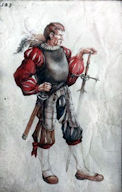
|

Dietrich Eckart, memorialized
|

|

|

Bronze bust of Dietrich Eckart that was in the NSDAP's Braune Haus
|

Home of Dietrich Eckart in the Obersalzberg
|
|
Two Landsknecht Tapestries from the Home of Dietrich Eckart, Connoisseur of the Arts (Item ART 18-5; LAND 2-4; PERS 7-2)
|
DESCRIPTION: These two fantastic hand-woven tapestries once graced the walls of the Berchtesgaden Bavarian home of the man that Adolf Hitler called his mentor; this was Dietrich Eckart (1868-1923). Eckart began his career as a journalist and poet. He blamed his earlier lack of success on the Jews and Marxists. He also blamed the socialists for Germany’s defeat in WWI and in 1918, entered politics and created one of his several poems—the battle cry “Deutschland Erwache!” (“Germany Awake!”). Eckart was an early member of the German Workers’ Party that evolved into the National Socialist Workers’ Party (Nazi Party). He began a close friendship with Adolf Hitler and introduced the awkward, young politician to the “right” people in Munich. He also encouraged Hitler in his political agendas and nationalist aspirations. Eckart’s “Storm Song” was the oldest national hymn of the N.S. Party. In a pamphlet published shortly before his death, Eckart hailed Hitler as the man who would reveal the whole conspiracy of the left. (He often said that Moses was the first Bolshevist.) Eckart was in essence the father of the N.S. Party and for a time he did “awaken” the Germans—they listened to him; at least in Munich, Haupstadt der Bewegung,” (Capital of the Movement) and after Hitler had made his mark, that city and all of Germany listened to Eckart’s protégé. Information passed to us from German historian sources lead us to believe that Herr Eckart was a lover of the arts. We do know that he was independently wealthy and enjoyed the art and music of the Germanic peoples throughout the ages. He loved and strongly identified with Henrik Ibsen’s Peer Gynt. His father was a royal notary and law counselor in Nuremberg and was independently wealthy. The father was a collector of the finest in objects d’art. Dietrich became a playwright in Berlin under the tutelage of Georg Graf von Hülsen–Haeseler. During this time Dietrich developed an ideology of what has to be termed “genius” (higher human strata) at one point based on earlier writings by Lanz von Liebenfes. He joined the Thule Society in 1913 and became politically active in 1915. He wrote the nationalist play “Heinrich der Hohenstauffe” (“Heinrich of the High Baptism”) in which he postulated a claim to world leadership for the German people. Much more about this man of destiny can be Googled, but please read between the lines. Political correctness does have a way with defamation. This was the man to whom Hitler dedicated the first volume of Mein Kampf. During all of this fantastic and colorful career he was known to have strong interests in the collecting of Germanic art, a favorite subject in which he indulged himself. There were various art objects that depicted German warriors: from the fighting men like Arminius the Liberator (commonly called “Hermann”) who defeated Roman legions in the Battle of the Teutoberg Forest in the year 9 A.D., to Frederick Barbarossa’s knights. But, especially, he adored the stories of the Germanic Landsknechte, the colorful mercenary soldiers who had a formidable reputation and were to become an important professional warlike force through the late fifteenth and sixteenth centuries. They consisted predominantly of German mercenary pikemen and supporting foot soldiers and they achieved the reputation for being the best universal soldiers for hire in early modern Europe. Landsknechte typically came from Swabia, Alsace, Tyrol, and the Rhineland.
These two magnificent tapestries depicting typical German Landsknecht soldiers were taken from the villa of Dietrich Eckart in Berchtesgaden by an agent enlisted by the OSS, which eventually became the CIA. Locals in that picturesque Bavarian community tell us that this particular house is still in use by the CIA. We cannot offer any educated backup knowledge of this, but that is the rumor. This has been an incredible journey indeed and our information was supplied by the son of the now-deceased operative. We did not receive the tapestries from this man, but after we bought them from an antique dealer, we showed them in a private antique show. The son of this OSS official saw them and immediately approached us and identified the pieces as the very ones that his father had in his possession and later sold. The older gentleman had not even known at first that this was the house of Hitler’s mentor until he was filled in by senior staff officers who had such knowledge. There is no doubt whatever as to the location of the house, and it is well known to historians; I have seen it myself as have other military historians. It is still there: a very nice little Landhaus from which came these magnificent Landsknectsoldaten tapestries.
The Tapestries
The tapestries are rather large, and measured from inside the frame they are 5 feet x 2 1/2 feet. The frames are 1 ¼ inches wide and are what we would call “OK!” These magnificent European art objects deserve more elaborate framing and I am sure when the right collector or institution acquires them this might well be accomplished. When they were “liberated,” we believe they were in elegant frames, or so we are told, but because of the nature of the moment of “acquisition” the frames had to remain behind at the villa. As you can obviously see, the tapestries are still showing the incredible artwork used in their wonderful production and were, of course, hand produced using the weaving art form known as petit point, the finest woven art the world has ever seen. The normal way that human figures were done was by needle point. To accomplish anything like these two tapestries in petit-point weaving would be infinitely more difficult and in subjects as large as these would be a labor so arduous so as it would seem absolutely impossible. Certainly it could not and would not be accomplished today. We ask that you would just imagine the length of time, the considerable amount of years it would take to weave these two tapestries all by hand. If there would be a glimmer of doubt that this was entirely (Handarbeit) “handwork” one can look at the back and see where even the smallest detail is separately tied off by hand and again this is incredible petit point. The work is many times more tedious to do than needlepoint. Even If it had been the larger weave it still would have been worthy of museum display. Petit-point works are so extremely rare—especially when of antiquity. Most are in museums and in many cases they are considered national treasures. I believe these could and should fall into that category. It is certain that Herr Eckart did! The soldiers are just as elaborately ornamental as you could possibly imagine. They have a unique three-dimensional effect. The embellishments are ornately superb and the artist was very knowledgeable of the Landsknecht costuming, weaponry, and historical presence. No European museum curator could possibly portray these tough mercenary fighters better. The soldier on the right holds a pike that was the initial weapon of these cadres (pikemen). He also has the great two-handed sword that has come to be known worldwide as the Landsknecht sword, “Zweihänder.” He also wears the short sword known as the Katzbalger. Beside him is seen a shield that depicts a mountain flower. Actually this same flower is seen in over 70 depictions in the background of the tapestries each one hand woven individually into the entire scheme. The figure on the left has a rapier (heavy sword), and he wears in his belt the Swiss-style mercenary dagger that is what the Nazi SA dagger was modeled after in the Third Reich. Beside him you can see a shield bearing two rampant lions. Both men are dressed in extremely exuberant costumes as Landsknechts always wore. It was the historical signature of the mercenary profession in that turbulent time. It seemed to be the rule that if a soldier was very handsomely attired, the more he had a genuine appeal to those who sought to hire him. We must note that these artworks are very handsome to an exceedingly intense degree and surely are without a doubt two distinct treasures of the Western world. Now comes the rather disappointing part. After these two tapestries were framed and set to be featured in a high-art auction, there came a time that they were sadly set in a place in the auction house where they shouldn’t have been. This was inexcusable and one tapestry was actually lying on top of the other and then tragedy struck! There was a large paper tarp placed over them to keep them clean and their being in that location was to be very temporary, but in the hectic goings-on there on that day, along came a stock attendant and seeing the white paper he thought it to be a table top and he placed an extremely heavy object right on top and needless to say this object plunged right through the precious tapestries like a knife through butter–tragic? Most certainly! Did they lose all value? NO! They still are what they are. Did they lose very significant value? YES! The reserve price of these fantastic items was simply astounding. The insurance settlement was even more than astounding. Later, we were offered them and after seeing them we just had to have them. Why? Because of all we have said about them in this essay we still truly feel they are extremely important historical items and possess sheer beauty and to us the fact that they were owned by one of German history’s most important and possibly most infamous individuals does give them some significant additional prestige. However, they do stand on their own as what I can only describe as masterpieces of the weaver’s art. The damage is very noticeable when looking at them close up and a more professional repair could make them fairly whole again, but it would necessitate finding an artist who would be able to duplicate the Old World skills and frankly we do not think anyone today would be in the least capable of this. (*Our opinion). The damage is as follows: the tapestry on the right in our pictures has a gash from the bottom of the pike’s point and blade down to the hat of the man’s head and down along the outside area along the man’s face, but incredibly missing the face–thank goodness! It continues for a short distance along the sleeve of the costume. The gash on the figure on the left begins at the top of the banner and travels down through the ensign and then proceeds both right and left and then surrounds the large white hat plume and the Landsknecht hat and down to the pom-pom decoration in the center of the standard. After tracing along on the hat plume it travels about nine inches into the background and by some miracle it also missed the face. The repair that was attempted looks rather crude, but when one looks at the figures straight on, the repairs are not quickly noticeable. They are still of such a quality that any trained eye that will appreciate such excellence might just forgive their past misfortune. It is beyond incredible that the faces were missed in the horrid accident. Remember Venus de Milo is missing her arms and Nefertiti lost an eye, but they are still loved and adored. These tapestries will without a doubt end up being a prized display in a museum, someday. In the meantime, we enjoy the privilege of stewardship. Congratulations Dietrich Eckart for having owned them. Deutschland Erwache!
PRICE: Price on request: Serious inquiries only, please
|
|
|
|
Goetz Medal “Invasion 1944” (Item ART 18-6)
|
| DESCRIPTION: Here is a medal that tells it all: The tragedy of the German soldier and the abject terror brought to European civilization by the forces of the allies. The apocalyptical riders of England, America, and the Soviet Russian ride along with the Grim Reaper as they attack Europe, represented by the maiden on the bull. The flames abound as the “terrorists” ply their nefarious destruction and murder fest. On the front side is a depiction of the German, shown as a knight errant. The scene is a takeoff of Albrecht Dürer’s Knight, Death, and the Devil. The soldier is fighting for the existence of his nation and the European Motherland, while the reality of death transform him into a soldier laureate, while the devil’s chicanery tries to grasp the sword out of the soldier’s hand and we know he succeeded and with it ends a heroic, but futile struggle to beat back the forces of Bolshevism and rampant western imperialism. Europe was devastated and thrown back 100 years and the victorious allies were losers also in many ways. We should never forget the honorable German soldiers who fought and suffered for 6 years and those who died for their country during this horrible fratricidal war. We should also take pause to remember the hundreds of thousands that were murdered after WWII officially ended. Ich Hat einen Kameraden einen Besseren findst du nicht, “Once I had a comrade, a better one you would not find.” The words around the edges of the medal are: “Um des Reiches und Europas Schicksal,” “For the Reich’s and Europe’s fate.” The medal says in a few pictures what we couldn’t say in a thousand words. Karl Goetz, 1875-1950, was Germany’s master medalist. In 40 years he created 633 masterpiece medals. His work always aroused the enthusiasm of German patriots all through the great war for civilization that civilization lost. The medal is struck in bronze and is one of Goetz’s largest; nearly 4 1/2 inches in diameter. The condition is excellent, rare, and prodigiously important. This is one of the largest Goetz medallions we have ever encountered and the rarity must be noted. I think that this most meaningful piece was possibly last large medallion that the great medalist ever produced in the period of WW II.
PRICE: SOLD
|

|

|
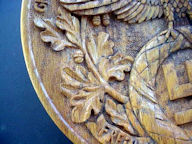
|

|

The wire hanger was added by the consigner.
|
Beautifully Carved Wooden Plate from the “Kampfzeit” (Struggle for Power) (Item ART 18-7; NSD 22-3; SA 15-2; WOODMASTER 1-12; BRE 1-7)
|
|
DESCRIPTION: This is without a doubt the most beautiful carved commemorative plate that we have ever seen and certainly with the greatest meaning. In 1933, Adolf Hitler was appointed as Reichs Chancellor. The whole meaning of the plate is to commemorate this important world event. The plate has at the top a swastika within the figure of rising a sun. The central design is the large, early NS Party eagle perched upon the early nonmobile swastika that is within a wreath with the date “1933” below it. The meaning is quite deep and has to do with the Machtergreifung (The Seizure of Power). Behind the eagle’s wings are sprays of oak leaves and acorns, the ancient German symbol of victory. Along the edges are the separate cutout words “GROßDEUTSCHLANDS ERWACHEN” (Greater Germany’s Awakening). Below the wreathed swastika are the watchwords (“Freedom and Bread”) of the NS movement “Freiheit u. Brot.” The plate measures 11 inches in diameter. It is in wonderful condition with no parts of the carving missing. All of the artwork is deeply cut and raised. It is probably the finest woodcarving that we have ever seen and would be considered not only extremely rare but also exceedingly beautiful when one looks at the carved wording that is all individually hand cut with fantastic skill; you can realize that this is one of the true artistic treasures of the early Third Reich.
PRICE: SOLD
|

|

| 
"Those eyes!"
|

|

|

|

Original wood-and-velvet framing
|

Signature illegible
|
Original Period Oil Painting of Adolf Hitler (Item ART 18-8; ANTIQUE HITLER 1-1)
|
|
DESCRIPTION: Here is a very notable depiction in oil of the Führer Adolf Hitler in 1933, when President of the Reich Paul von Hindenburg appointed him Chancellor of Germany. The patriots of Germany were so overjoyed that many of the artists brought forth portraits in oils or watercolors of their hero. Some of these works were very professional such as the one we offer here, and others were rather amateurish, but still accomplished with love and devotion to this remarkable man and the German Fatherland that he promised to make great again. Is that a familiar phrase?. We know that he definitely did so until the forces of Communism and in fact Capitalism brought him and Germany down, but for 18 years the Aryan Utopia that can be called the Imperium of the western world indeed excelled in a wonderful advanced civilization. It has often been said that Hitler had remarkable deep-blue eyes which persons including Traudl Junge, his last secretary, referred to unequivocally as having a distinctly hypnotic quality. Paul Joseph Goebbels described his first meeting with Adolf Hitler in his diary. He said: “He shakes my hand like an old friend and those big, blue eyes are like stars. He is glad to see me. I am in heaven! That man has everything to be king.” We make these historical observations because it appears that the artist that executed this portrait has more than faithfully brought out those magnetic eyes in greater authenticity and feeling than any other depiction we have ever seen of the Führer. The brilliant handling of the face is greatly professional and the artist brings out quite authentically the subject’s Prussian military hairstyle flowing forward and to the side. He also visits quite professionally the famous facial hair called a “toothbrush moustache.” The Führer is seen here wearing his historically famous trench coat while underneath we can see a brown tunic with cross belt strap and necktie with an N.S. eagle stickpin attached. The painting is signed in reddish color up in the very top-right corner. However, we cannot make it out the signature. The painting is on board not canvas which is of course often more conducive to gaining high detail in facial portraiture than if done on canvas that is if practically photographic quality is sought after and achieved. This was certainly achieved in this case. The portrait is mounted in what obviously is a period frame tinted in gold upon the wood. The matting is deluxe in that it is of genuine soft, brown velvet fabric sometimes used in the 1930s in framing special art renderings. The actual painting measures 17½ by 14½ inches while the four tiered frame measures on the outside 25 x 22 inches. The painting is in excellent shape without any noticeable scratches or abrasions and the superb frame is in perfect condition, as well. This is an absolutely stunning rendering of the man whom TIME magazine called “The Man of the Year” in its annual issue of 1938. No individual ever put his name and countenance on history more than this man and practically all the biographers take completely dubious license in telling his saga (generally falsified and almost always fabricated, purposely misleading and in many instances entirely concocted). So, in peril of repetitive discourse, I have to say here is one of the best artistic likenesses of the German leader that we have ever encountered or been able to offer the collecting field. You would be truly fortunate to procure this magnificent portrait.
PRICE: $3,650.00; Special offer by our consignor-worth much more!
Footnote: A book that transcends all the politically correct prevarications was written by our historic researcher and curator. The title of the book is Gun of Destiny and you can go to Amazonbooks.com and see it along with its many 5-star reviews.
|
|
|
|
Magnificent Black Forest Carving Depicting Adolf Hitler (Item ART 18-9; AH 31-1)
|
| DESCRIPTION: In 1933, Germany experienced the Machtergreifung, Adolf Hitler's victory and ascension to power when Reichs president Paul von Hindenburg appointed him to the office of Chancellor of the German Reich. The church bells in all of Germany rang in jubilant cheer and the faithful National Socialist supporters were ecstatic with hope and pride at this highly auspicious occasion. Almost before Hitler physically entered the Reichstag, artists both professional and amateur were busy turning out charming figurines, paintings, drawings, and all sorts of art depicting their leader. The piece we offer here is a woodcarving in the traditional Black Forest style. For centuries throughout the dense Schwartzwald there have been expert woodcarvers. Their usual specialties were the famous coo-coo clocks, but carvings of forest animals were also made. Masterfully carved forest creatures and colorful local folk in their typical native and sectional costumes are prevalent. In Europe, finer Black Forest carvings became a symbol of luxury and wealth. The finest of these were often found in royal collections and elite collectors’ homes. Victorian world travelers adored these items and paid heavily to acquire them. During the period 1806 through the 1900s, the popularity was also growing in many overseas markets, as well. Some of the figures that warmed the hearts of Americans were boars—the most commonly depicted animal—stags, eagles, dogs, and of course important and often-humorous human figures were common when depicting woodland folk, but with this particular depiction we offer here, very special and masterful detail had to be achieved as no doubt this was a very special project possibly commissioned by a local town council or even the Bürgermeister to commemorate the earth-shattering event when the former Grand Marshal of the Army and now the Reichs president conferred this supreme leadership on a former corporal in a Bavarian infantry regiment. The facial expression in this magnificent carving is nothing short of amazing! To achieve this degree of perfection in woodcarving is very notable indeed and the artist that turned out this impressively beautiful and striking artwork had to be a highly rated virtuoso in this demanding field. Note in our images the column support of the bust. Its whole message seems to convey the message “The Awakening” and advancement of the Third German Reich; the rising sun portrays this idea. The heads of the eagles seem to depict the boldness of the coming era and its promise of a Teutonic national identity. This sculpture by a highly skilled artisan of his day seems to say it all. It is truly a great and exquisite rendering that is surely unique!
PRICE: $2,950.00
|

|

|

|

|

|

|

|
Utterly Fantastic and Original Important Photograph Album (Item ART 18-10; NSD 22-5; ALBUM 4-12; SPECIAL ITEMS)
|
|
DESCRIPTION: Here is the most important photo album we have ever seen, and certainly the finest. The pictures are brilliant and to a point of absolute photographic perfection! There are 195 photos that seem to say it all about the Third Reich’s “Imperium”! It starts with pictures of the Haus der Deutschen Kunst from the time when this beautiful building contained gorgeous artistic renderings that staggered the viewer with charm and strength, patriotism, and decent emotion aforethought, unlike what utter degenerate trash that has been thrust into those hallowed halls today after they removed the word Deutschen. There are about 16 pages that fantastically chronicle the finest and greatest parade that anyone can envision since the triumphal Roman legions in their celebrations of victory. The beautiful trappings for the celebration and procession are shown making the old city bright and radiant by night and day and then the march known as “2,000 Years of German Culture” follows. The parade begins with full battle-ready Viking ships and Norse warriors. Father Rhine is depicted in a boat surrounded by Rhine maidens, knights on horseback, celestial floats, Wagnerian themes, knights and emperors, Goths and Deities, and eagles galore! The massive and stately Richard Klein eagle and swastika are seen on a float. There is a model of the Reichstagsgebäude in Berlin, runners carrying torches from the 1936 Olympics, a regiment of Grenadiers from the time of Frederick the Great, and a final picture of Wehrmacht (Army) (Heer) presenting its colors to a military assembly. Also, there’s a march past the SS-Leibstandarte and after that there are six pages showing the preparation for the visit of Benito Mussolini to Munich as a guest of Adolf Hitler in September 1937. The stately Roman and Reich eagles are shown everywhere and the Munich gate entrances are bedecked with large “M” letters to honor the great and most welcome head of the Fascist Italian state. There are a couple of great pictures of Adolf Hitler and Mussolini standing in front of the Führerbau with troops marching by (utterly fantastic!). Then, there are pictures of celebrations and commemorations of the sacred November 9 Day and march to the Feldherrenhalle. This ceremony occurred on November 9 every year and the marchers were mostly the original participants in the Beer Hall Putsch. The first photo has Julius Streicher singularly leading the parade then P.G. SS Jakob Grimminger with the Blutfahne (Blood Flag) then in the third frame Adolf Hitler and other Alte Kämpfer bring up the middle and following this there are four more great pictures of this Feldherrenhalle march. Then there are several pages of march-by of the SA, SS, NSKK, Hitler Youth, and Political Leaders Corps all marching in glorious unity through the streets of Munich. Then there are several pages devoted to an exhibition of the Reichsnährstand—an independent organization of the agricultural economy and agricultural policy in the German Reich. Its charismatic leader, Walther Darré, wished to extol peasant values as found in the Nordic race like no other! There are a couple of pages devoted to the sacred Rhine River and the N.S. industrialization, thereof. Then comes about five pages of the greatest photos of SA ceremonies, reviews, a party funeral, a high-ranking NS political leader addressing wounded war vets. There are some really charming, but bold, pictures of SA and NSKK men at work and rest. Among these can be seen a highly decorated member of the N.S. Gauleitung addressing the faithful. There are some great close-ups of the patriotic zeal of the rank and file “Brownshirts.” After this, there are a few photos of the Munich rural areas and inner city and some of Salzburg, wonderful and typical Bavarian housing, etc. On the last the page we see the Völkerschlachtdenkmal of Leipzig, the most glorious monument commemorating the battle of nations against Napoleon in 1812. And on the last page is seen the airship Hindenburg as it floats over the German countryside. The photographer who created this magnificent album was obviously a very professional lens artist and except for a couple of out of focus photos of the November 9th march, the rest of the 193 photos are simply consummate perfection! He obviously had some granted authority from the NSDAP to be able to take such great photographs at such close range of some these high-security events. He may have even been a member of the Political Leaders Corps. In any event, he has left a grand and important record of the time of the German “Imperium.” This large album measures 16 x 12 inches and is quite heavy: about five pounds. The leather covers are perfect front and back. Most of the photographs have handwritten captions—in German—underneath each one, but not on the pictures, rather the writing is on the album paper. All the pages have the typical onionskin dividers. This precious ultraimportant archival treasure must be preserved. Hitler said at the 1937 opening of the House of Deutschen Kunst: “No people live longer than the documentation of their culture.” “Kien Volk lebt Länger als die Documente seiner Kultur.“
PRICE: SOLD
*PS. Since acquiring this masterpiece album and subsequent to our writing its description, we have acquired copy of the N.S. woman’s magazine Frauen-Warte from August 1939. The cover and some of the inner text are devoted to the day of German art and other vastly important and interesting subjects dealing with “true art.” This rare publication will be included with the album.
|

|

An NSDAP ceremonial plate 1937/38
|

A symbolic sword-pike for Gauleiter Josef Grohé; made by Berthold in 1936
|
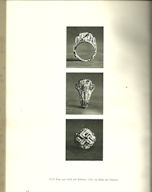
The famous Hitler ring in the Berthold book
|

A magnificent sword made for Hermann Göring by Berthold
|

National prize for Excellence in Athletics 1938
|

From the special collection of the Führer in Berlin
|

Chain of office for the director of the Braunschweig Technical University
|

From the private collection of Reichsmarschall Hermann Göring by Karl Berthold
|

Reliquary of Heinrich the Lion in the cathedral of Braunschweig
|

Foldout depicting the golden model of the city of Cologne as envisioned from the heavens. This was a gift to Adolf Hitler on his 50th birthday in 1939
|
Book Entitled Karl Berthold: Ein Deutscher Goldschmied by Adolf Feulner (Item ART 18-11; RAREBOOK 2-25)
|
DESCRIPTION:This is a rare original art book from the Third Reich, not a reprint! The master goldsmith Karl Berthold and his talented artist wife Maria Schmidt-Kugel turned out some truly artistic masterpieces in their time. Karl (1889-1975) came from a family of goldsmiths in Bavaria where he was first trained. He became a teacher for goldsmithing at the Staatliche Zeichenakademie in Hanau and Werkkunstschule in Cologne. After the war, his studio was in the Carmelite Cloisters in Reisach, Upper Bavaria (1945-1951) and later Oberaudorf/Inn. His designs were heavily inspired by Renaissance and Baroque art for which he more-than-excelled in. During the German Third Reich, he reached the Imperium of his magnificent perfection in art. Not too long ago a ring showed up in the collector field. It was a fantastic jeweled piece no doubt the most overwhelming piece of N.S.-connected jewelry ever found to date. It was said to have been a gift to Adolf Hitler; however, there was quite a donnybrook over it and one old grizzled and well-known crook in Charlottesville, Virginia, said the ring was an outright fantasy piece and it never existed let alone being a gift to the Führer. Well on page 62 of this period book, there it is, an image of the ring with the caption: “Ring aus Gold mit Rubinen. 1930 Im Berlin des Führers.” This obviously is the very same ring, but considering some of the sleazy characters involved in the handling and selling of it, suspicions are surely understood. The ring eventually brought $66,000, but unfortunately at an auction house owned and managed by the dirtiest crook in the business.
The Book
The book is in excellent condition with original dust cover. It was probably published in December 1939. It has 83 pages of photographs of Berthold’s masterpieces to include a wonderful large fold-out “dream scene” that might have been inspired by Hitler’s vision of the future of Berlin as GERMANIA. This fantastic three-dimensional model (see our images) was presented to Adolf Hitler in 1939 for his birthday. The book measures 10 1/2 x 8 inches and is in near-mint condition. We know of no other original copy available anywhere. This is an incredibly rare edition.
PRICE: $350.00; absolute original N.S.-period copy; not a reprint!
|
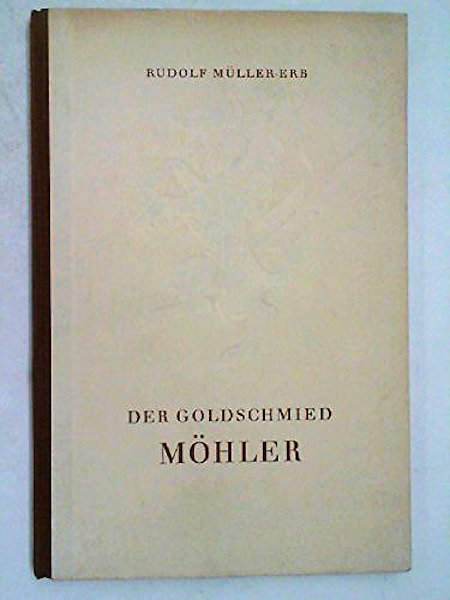
|

Town’s high mayor wearing the Oberbürgermeister chain crafted by Möhler
|
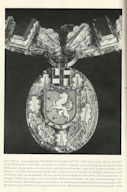
Close-up of Oberbürgermeister Konrad’s chain of office
|

Containers for German homeland soil for N.S. patriots outside the Reich
|

The one-of-a-kind unicorn of Schwäbisch Gmünd
|

Heredity plate for a family of nobility
|

Silver-and-pearl crown to honor General Field Marshal Albrecht von Württemberg
|

Crest rings for noble families
|
Der Goldschmied Möhler (The Goldsmith Möhler); An Original Rare Edition (Item ART 18-12; RAREBOOK 2-26)
|
|
DESCRIPTION:Here is one of the most beautiful and important books we have ever handled. It is a very limited printing in 1941 in Stuttgart with 45 wonderful jeweled masterpieces—please underline masterpieces!. Herr Möhler was absolutely uncontested in his field as the greatest master worker and jeweler in his home gallery and workshop in Schwäbisch Gmünd, a town in the eastern part of the German state of Baden-Württemberg. Accompanying each photo is a poetic verbiage having to do with the fantastic item viewed. On the opening pages is a picture of the Lord Mayor of Schwäbisch Gmünd wearing the most beautiful chain of office his (Neuen Amtskette) made by Herr Möhler. It is proudly worn by Oberbürgermeister F J. Konrad and on the left facing page is a poem dedicated to the Schwäbischlande. The next two pages show close-ups of the main fob of this the greatest Bürgermeisterkette ever designed and produced in the Third Reich. Then there are many more beautiful black-and-white professional photos of other masterworks by this master goldsmith and silversmith, Fritz Möhler: Pokals, Becher, exquisite finger rings all with appropriate poetic quotations appearing throughout the pages. On page 23 there is a magnificent eight-position candelabra that particularly stands out. On pages 25 and 26, you will see the most stunning piece of equestrian jewelry that we have ever seen. It is a highly stylized portrayal of a unicorn that is part and parcel of the arms of Schwaben Gmünd. It’s much too complex to describe here (see photos). There is another beautiful mayor’s chain of office made in silver and plated in gold shown on page 57 and it was for the Oberbürgermeister of the city of Reutlingen. On page 47 is a plaque that has the gorgeous full arms of the famed elector of Schwäbisch Gmünd. If there is a title given to the master jeweler of all time, it would belong to Carl Fabergé, but he would be in a near tie with Fritz Möhler. This book is in mint condition.
PRICE: $325.00. There are copies of this title available on Amazon, but this is the original hardbound, PERIOD edition for the serious collector.
|
 |

A concert held in Berlin in 1938 at the opera house sponsored by the KDF (Strength through Joy Movement). The event was to celebrate the works of the Reich’s Culture Chamber--Dr. Goebbels speaks.
|
|
|
Reich's Culture Chamber Stickpin (Item ART 18-13; PINS 4-12; NSD 22-6)
|
| DESCRIPTION: This is one of the most sought-after and rare of all stickpins. It is for the Reichskulturkammer, RKK. This was the inner party organization that managed and directed, museums, art galleries, etc., in the world of Teutonic culture. This is extremely rare and one of the most beautifully designed pins of the Third Reich. This stickpin is well marked with the signature of the very famous firm of Deschler in Munich. It is also marked with the traditional "Ges. Gesch." The item is in genuine 800 silver.
PRICE: $450.00
|

|

|
Three Issues of Grosse Deutsche Kunstausstellung) (Item ART 18-15)
|
DESCRIPTION:Here is a group of the prestigious catalogs from the exhibition of the German National fine art; art for humans, not apes!
The issues we offer are as follows:
Issue 1940 - Very fine shape
Issue 1942 - Pretty good shape
Issue 1943- Not bad at all!
All these issues are chock full of neat Wehrmacht- and NSDAP-inspired art as well as beautiful nudes and stirring landscapes. This was the Imperium of European realistic and heroic art. If you go to what is called Haus der Kunst right there in the original building you will be confronted with hundreds of pieces of the most hideous, filthy garbage ever offered by a bevy of the most insane lot of so-called artists, whose offerings would seem to have been painted or sculpted by monkeys on speed! WE offer the three catalog editions at a bargain price.
PRICE: $195.00
|

|

|
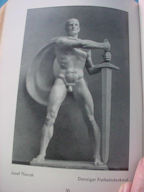
|

Automobile advertisement near back of book
|

Advertisement for mineral water
|
Book Grosse Deutsche Kunstausstellung 1943 (Great German Art Exhibition 1943) (Item ART 18-16)
|
|
DESCRIPTION:This is the 1943 catalog for the art showing in the Haus der Deutschen Kunst. Look at the description of the set of three above for further explanation of these magnificent publications, and my critique on the presently shown exhibits. The title description that once included the word “German” (Deutschen) has been removed and that’s probably just as well seeing as how the “art”shown now is anything but German; actually it should termed (Entartete Kunst) because for the most part it is degenerate art similar to the special exhibition of such garbage that was held in Munich in 1937. Hitler had declared a merciless war on cultural disintegration! The edition we offer here is a 1943 volume comprised of 66 pages of painting, sculptures, and 68 pages of explanatory text and indexes to the art within. The cover front and back is a little bit distressed, but all the pages are in excellent condition. The contents shown are of superlative art never to be seen again except for a few pieces that have survived the culture war against true art.
PRICE: $60.00; special price
|

|

Woman even more than men admired Adolf Hitler.
|

|
Mirror of the Movement (Item ART 18-17; NSD 22-7)
|
|
DESCRIPTION:It was often said that the NSDAP was the mirror of Nordic and Teutonic Imperium as in Grecian and Roman culture. Here is a little trinket of the type that might be presented to participants in a fund-raising dinner or other patriotic event sponsored by the N.S. culture chamber. It’s probably the neatest, petite gift that would have been devised for the culturally aware patriots among the faithful. It looks like the hand mirror as used by the nobility of old who were now the nobility of National Socialism. The overall size of the mirror is slightly over 3 inches long. The mirror glass is clear and framed into a silver-colored, round, open, bedecked floral motif the center of which shows the early N.S. eagle and swastika. The handle of the mirror is decorated with further floral ornamentation. This little instrument is exceedingly rare and we believe very historically important to the culture-bearing stratum particularly inherent our field of collecting.
PRICE: $450.00
|
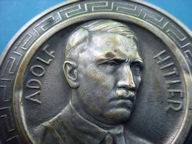
|

|
Interesting NS Pocket Mirror (Item ART 18-18; NSD 22-8)
|
| DESCRIPTION: Here is a pocket mirror as would be carried in the purse of a patriotic woman in the 1920s and 30s that bears the likeness of her Führer, Adolf Hitler. It’s an undeniable fact that he was beloved by the German folk in general, but especially among the women of the nation. This is emphasized in the book Gun of Destiny by Robert A. Johnston available through us. The mirror is the typical size as popular with the ladies: 2½ inches in diameter with a depiction of the Führer and the title of his name. The edging of the roundel is decorated in the Greek key pattern personally designed by Hitler and is similar to what is seen on his personal tableware. This was a favored design pattern for the leader for many NS items. The glass side is perfect and not at all scratched and so is the obverse side. Politically inspired mirrors like this are quite rare and seldom seen in the collecting world today. Condition=Excellent!
PRICE: $350.00
|

|

There are many fine advertisements for art galleries such as
this in the last pages of the catalogs.
|

This is one of the of many great advertisements
in the last pages of the catalog.
|
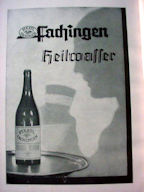
Another advertisement
|

Another advertisement
|

Another advertisement
|
Images from Five Great Issues of the Pictorial Catalogs from the House of German Art (Item ART 18-19)
|
| DESCRIPTION: Here is a smattering of images that depict the art of the Third Reich. They grace the pages of five of the issues from the House of German Art in Munich. This is art in its richest form—unmatched in the entire world for its realism and purity, heroism, patriotism, and nobility of purpose. These themes are portrayed throughout the pages. Many of the presentments were produced by artists in a time when otherwise degenerate art was seen in galleries throughout the pre-Hitler era. Unfortunately, if you travel to Munich nowadays and visit the “House of Art” (notice the word “German” is removed), you will see the whole building is now devoted to the display of trash of the lowest order—Entartete Kunst (Degenerate art). The softcover books offered here are issues 1939-1943, and all are in very good shape except for a couple of minor spine issues (truly minor). Seldom, if ever, are these catalogs found in this condition, and to find copies in sequence like this is remarkable! When other groups of these issues have been offered, the one that always seems to be absent is the “1939” issue. In this group, our “’39” is there and in practically mint condition. This certainly is a great archival set.
PRICE: $375.00
|

|

|
Wehrmacht Frontline Sketch Art (Item ART 18-20)
|
| DESCRIPTION: Published in 1941, this is a neat little book of drawings by a German frontline artist by the name of Ernst Eigener. Inside Mein Skizzenbuch (My Sketchbook) are some 53 pages of illustrations and sketches graphically drawn with vivid, explicit details of German soldiers and their struggles during the 1940 French and Africa campaigns. Great sketches abound of artillery, close combat, mortar teams, tanks, cavalry with their horses, motorcycle dispatch riders, burned houses from British bombings, and just great renderings of German infantrymen. Also inside are sketches of enemy POWs such as N. African negroids and Arabs. If one wanted an all-around pictorial account of the first stages of the Second World War, here it is in realistic art by a frontline participant. The book is petite measuring 7½ x 5½ inches. The spine is missing, but the book is holding up well and the pages are in excellent condition. The cover is somewhat stained, but still presentable; soiled, but still an important piece of history.
PRICE: $75.00
|

|

|
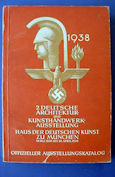
Special rare architectural issue
|
Special Catalogues for the House of German Art (Item ART 18-21)
|
| DESCRIPTION: Here is one of the only almost-complete sets of the Grosse Deutsche Kunstausstellung that we have ever seen offered. It consists of the special numbers to include all the issues from 1937 through 1943, but an additional bonus is realized when you see the very rare and important special 1938 edition of the 2.Deutsche Architektur und Kunsthandwerk-Ausstellung. This was the German Architecture and Handicraft Exhibition and is featured in a separate, extra edition along with the regular book for 1938. All the catalogues are in extra-fine condition. Some of the art seen within these books can be seen in our other art and architecture sections at ART 18-15, ART 18-16, ART 18-19, ART 12-5, ART 14-8, and see the bound volume at ART 8-1. The collector the “Kunst “ magazines and catalogues came from is one of these culture-inspired special individuals who has for many years collected everything that was influenced by the beautiful national Art of the Third Reich. This extremely rare set is complete except for the 1944 edition, which would have been the last edition ever produced. In these wonderful art catalogues are photos of the works of the greatest masters such as Sepp Hiltz, Werner Peiner, Prof. Karl Diebitsch, Fritz Klimsch, Joseph Thorak, and many other masters of the realistic school. None are anything like the degenerative trash found in ‘the “House of Art “as it stands now. Note that the word "German" is now missing in the title; thank providence for that at least!! The wonderful building is the only great vestige left of what was struck down in an early sickening vestige of cancel culture. “Kein Volk lebt länger als die Dokumente seiner Kultur: “No people live longer than the documentation of their culture”! These words were spoken by Adolf Hitler on the occasion of the opening of the House of German Art July 18, 1937. These books are one of the last testimonies of the Grand Imperium of classic western art as it should be, and they should be preserved as such!
PRICE: SOLD
|

|
Beautiful Karl Diebitsch Watercolor (Item ART 18-22)
|
| DESCRIPTION: One of the most prolific and well-known artists of the Third Reich and Hitler’s personal favorite was Professor Karl Diebitsch. He and his wife were famous for their tapestries, the most famous one being “The Great Tapestry,” which we offer on our site. He was also an excellent painter and this watercolor is extraordinary in its detail and mellow colors of the Rolle Pass in the Dolomites in the northern Italian Alps. Done in 1965, it is on paper attached to Masonite board and measures 26 x 20 inches and is in excellent condition. It’s from the estate of Doctor Wolfgang Jilek, a famous psychologist from British Columbia. An exceptional watercolor as this from such a famed artist during a very turbulent time will only rise in value and is an excellent investment both artistically and historically. We are extremely fortunate and so proud to offer this amazing work of art!
PRICE: WITHDRAWN
|
|
|
|
Marvelous Reich Eagle Presentation to a Director of Agriculture (Item ART 18-23; AGRI 1-8; EAGLE 1-11)
|
DESCRIPTION: This very impressive bronze eagle is so indicative of the national spirit they had even in agriculture. It was given to a director named Koster, presented in December of 1939 and reads as follows:
“Dedicated to our learned, beloved agricultural Rat. Director Koster, in honor and thankfulness for his sacrifice and excellent performance.
Zwickau, Sachsen Agricultural Club.”
It stands 16 inches tall by 10 inches on a marble base. The detail is very distinct and well executed. It weighs 19 pounds.
PRICE: SOLD
|
Unusual Candelabra Set Associated with the Oberkommando des Heeres (Item ART 18-24; WEHR 35-20)
|
| This is a most unusual item that has ties to the Upper Command of the Army the Oberkommando des Heeres abbreviated to “OKH.” Founded in 1935, it was part of Hitler’s rearmament of Germany. It was the most important unit within German war planning until the defeat at Moscow in December 1941. Its responsibility was strategic planning of Armies and army groups. The OKH commander held the title of Commander in Chief of the Army. After the Battle of Moscow, the OKH commander Field Marshal Walther von Brauchitsch, was removed from office because of failing health, and Hitler appointed himself as Commander in Chief of the Army. Hitler would create the Oberkommando der Wehrmacht, which subordinated OKH to OKW. OKH was then limited to the Russian Front while OKW had direct authority over army units elsewhere. On April 28, 1945, two days before his suicide, Hitler subordinated OKH to OKW giving the latter command of forces on the Eastern Front. The candelabra with the striking matching candlestick holders has evaded us as to what the other letters and numbers signify, but the guess is that it is some divisional or other military designations. This set probably was in a dayroom or displayed in the headquarters of this unit. The candlesticks appear to have suffered fire or smoke damage as does the candelabra. The candelabra is 17 x 17 inches, while the candlesticks are 10 x 6 inches. Everything is in excellent condition despite the fire damage, but it should be as the set was made to last being constructed of heavy iron. We have never carried anything quite like this, but it certainly is unusual and definitely rare. We see all other manner of decorations which different units and divisions created for their military effect and adoration, but not one like this of the OKH. This was probably made early in the creation of the OKH. This is a real collectible!
SOLD
|

|

|
Decorative Third Reich Eagle (Item ART 18-25; EAGLE 1-12)
|
| Well, as you know, we love eagles, but this one is from an unknown source. It is a typical stylized Third Reich eagle and probably attached to something as the attachments are on the back. It’s of heavy steel so was no doubt on something outdoors and made to endure the elements. It measures 11 x 8 inches and is a very impressive piece!
PRICE: SOLD
|
|
|
|
Regal Reich Eagle (Item ART 18-26; EAGLE 1-13; NSD 22-25)
|
| DESCRIPTION: This eagle has a personality all its own. It‘s from the period on a marble base. The bottom has been replaced with green felt. The eagle seems to be of a base metal/zinc extraction. There are no hallmarks on the eagle, but its great detail signifies it did come from an established foundry. The eagle is 7 inches by 6 inches, while the base is 8 inches long by 1 inch high and weighs seven pounds. The obverse is just as detailed and one can see the swastika beneath the tail feathers. Expense was no object in its production for the eagle sits on Marquina (black marble) with its characteristic veins of crystalized minerals. This marble is rarer than Italian marble. This is the perfect addition to any collection where it will be a focal point of any room.
PRICE: SOLD
|

|
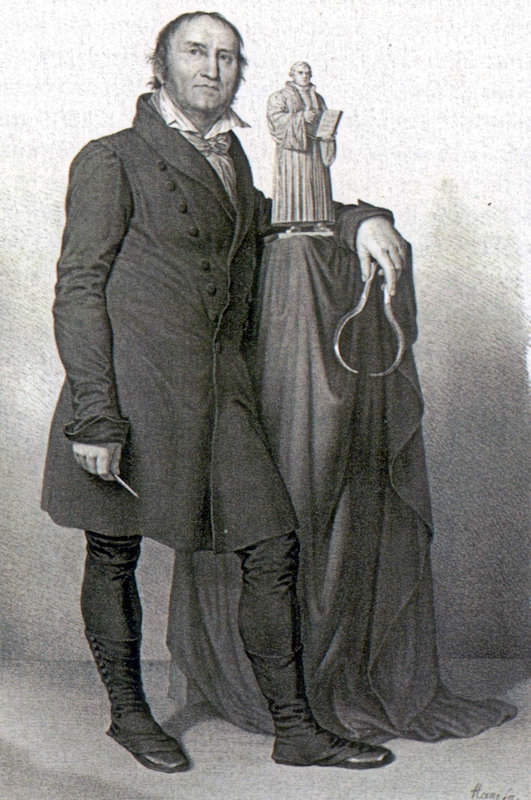
Johann Gottfried Schadow
|
|
Exquisite Porcelain Statue of Frederick the Great with his Dogs (Item ART 18-27; FRED 4-13; AH 31-28)
|
| DESCRIPTION: This is a sculpture that was executed by one of the finest artists of Prussia, Johann Gottfried Schadow (1764-1850). He was very famous for his highly detailed sculptures of famous people and he made the centerpiece of the Brandenburg Gate in Berlin. This porcelain was manufactured by the Thuringian (Rudolstadt Volkstedt) porcelain factory in 1945 being inscribed “nach Schadow’ or "after Schadow" on the base. That it was produced during the Third Reich is perhaps the resurgence of popularity Frederick the Great had being the favorite of Hitler, who had a painting of him in his office. There was also a very quality movie produced about him during the Third Reich. (One wonders if Hitler also had a copy of this famous porcelain.) Frederick the Great was very fond of his whippet hounds and the two shown here are Alcmene and Hasenfuss, their names on their collars. He had his dogs buried next to him. This porcelain stands an impressive 30 inches tall by 15-inches square at the base. The porcelain had a limit of 495 issues. The maker's mark is hard to pick up as it has bled during the molding so is not shown. It is in excellent condition; however, one of the dog’s tails in missing. His cane is of wood and removable. Usually, things like this are the first to be lost. The detail is just amazing; from his medals to his sword, the uniform, even his hat and gloves AND the artist placed little paw prints in the base! Schadow was well known for his realism and this piece definitely displays that. This is a rare opportunity to own a prestigious piece of art with a wonderful historical past.
PRICE: $8,000.00
|
|
|
|
Tremendous Porcelain Luftwaffe Award (Item ART 18-28; LUFT 23-13; THIRD REICH TABLEWARE 1-20)
|
| DESCRIPTION: This is truly an amazing collectible being an award to a Kampfgeschwader or "Fighter Squadron" as it states on the side with the Luftwaffe eagle proudly flying with swords on each side. Swastikas also adorn the sides of this beautiful artwork by the Unger and Schilde Roschützer Porzellanfabrik Company. It shows its mark of the knight’s helmet, which was in use from 1896 to 1953. Gold leaf is used to express the magnificence of the award given to this squadron. The cobalt blue has not lost its deep resonance, nor has the gold its luster. It’s 7 inches high by 6½ inches at the width of the top. It was acquired from Wittmann Militaria, so its authenticity is not questioned.
PRICE: $1,800.00
|
|
|
Carved Wooden National Third Reich Eagle (Item ART 18-29; EAGLE 1-16; NSD 22-37)
|
| DESCRIPTION: Well, as you know, we love eagles! This one is of a genre that is getting next to impossible to obtain unless they are re-created and this one is not. It shows all the natural wear and aging in the wood that we would expect of a period-carved eagle. It measures 19 inches wide x 17½ inches high, and is in excellent condition. The detail is most intricate in both the body and wings. This is a beautiful display piece!
PRICE: $5,000.00
|
|
|
|
Bronze Study of a German Soldier by the Known German Artist Fritz Paul Zimmer (Item ART 18-30; WEHR 35-22; BRONZEMET 4-15)
|
| DESCRIPTION: You can walk all over a militaria show and see small bronze or metal busts of German soldiers, the majority reproductions, but you will find hardly a one by a successful German artist. Born in Germany he migrated after WWI to America and had a most successful career as a sculptor. During WWII he remained in America while his brother Richard joined the American army Now, you would think that he would not be inclined to make a bust of a German soldier, but he had enough admiration to create one as you see here. It's most detailed on a marble base and is in excellent condition. It's an impressive one foot tall with the base. As you can see, it bears his signature on the back. Zimmer’s work can be seen all over Europe and the states and his biography on Wikipedia is well-worth the read. This is not only a sound militaria collectible, but an artistic one, as well.
PRICE: $2,100.00*
|
[Return Home]
Contact Us
Please refer to item designator in parentheses in all correspondence.
Please E-mail for any additional information you may need.
If you prefer, contact 'Germania' at PO Box 68, Lakemont, GA 30552
or call at 706.782.1668.
Please! do not call during the wee hours of the morning. The best time for calling us is between 9 and 11 am and between 9 and 11 pm
eastern time.
| |

![]()
